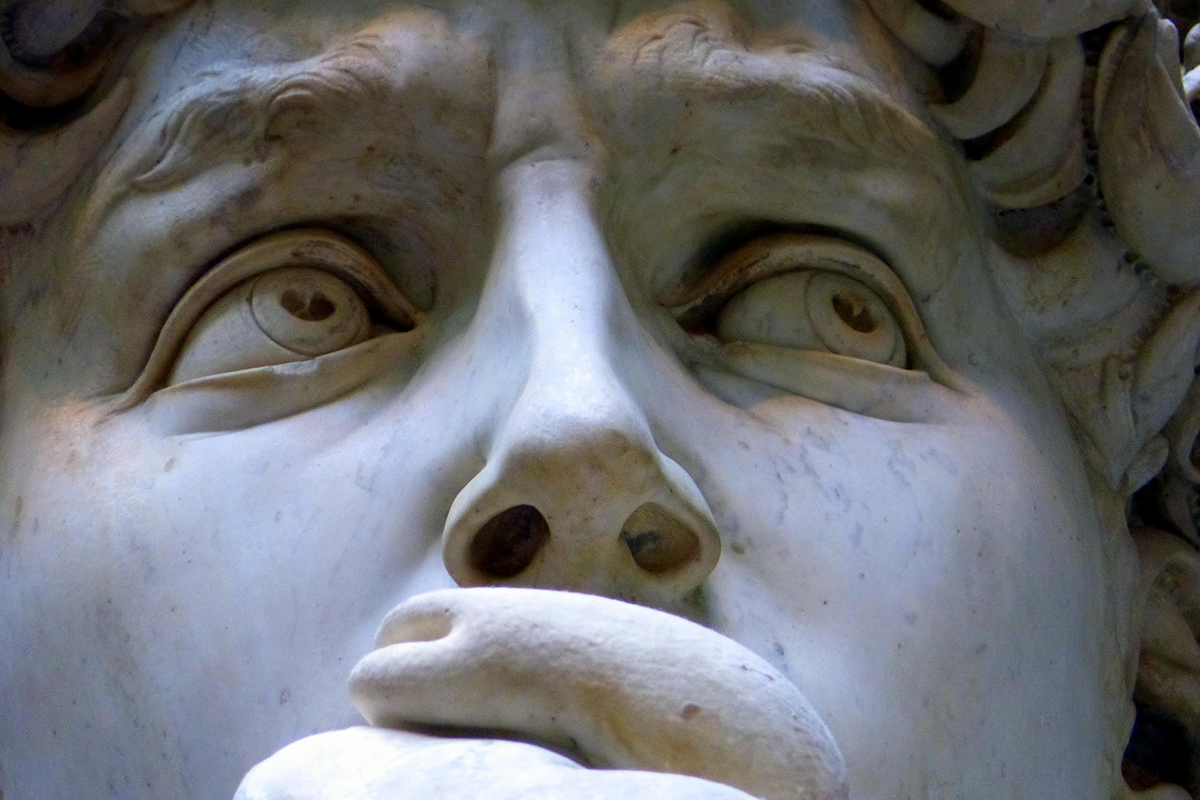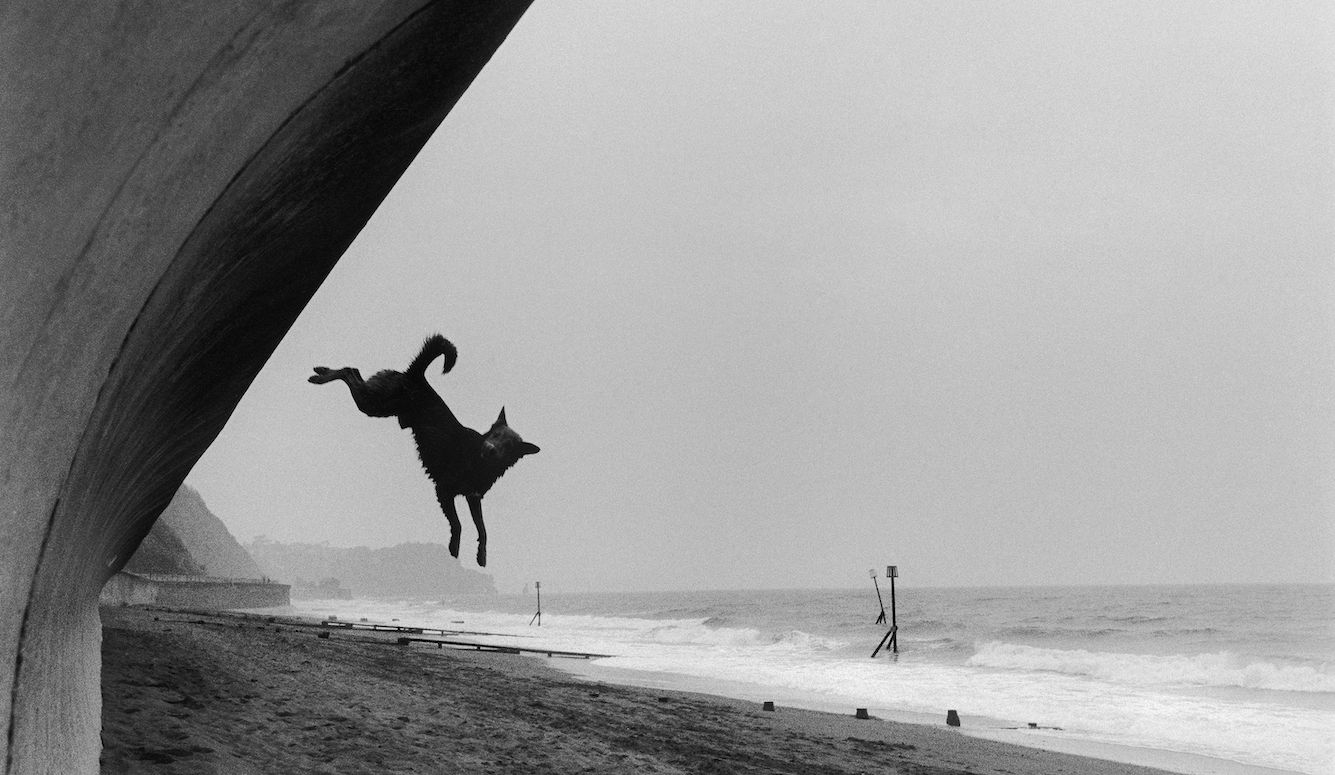Bill Viola
Old Masters Remix: A review of 'Life Death Rebirth', the Michaelangelo/Bill Viola exhibition at the Royal Academy
There is far more expression to be found in the Easter Island heads, than there is here.

The Royal Academy in London has mounted an exhibition with the very serious title of “LIFE DEATH REBIRTH,” putting video installations by the American artist Bill Viola (b.1951) together with some drawings by the Renaissance master Michelangelo (1475–1564).
Museum curators have increasingly been foisting such juxtapositions on us, because it is their job to worry about how we should respond to art and right now it feels as if the Old Masters are losing their appeal. Their religious and mythological themes no longer seem so “relevant,” because the will, and the incentives, to understand them are gone. So this new curatorial strategy, which we might call the “Old Master Remix,” is contrived to bring in different crowds at once: a bit of fashionable Contemporary Art will help to cause a stir, while conferring relevance again on the old by showing how it happens to resemble the new.
Equally, the most illustrious works of the past can help to confer a certain historical credibility on the contemporary artworks displayed alongside them—the association alone is enough to suggest that these new works will stand the test of time, with the approval of illustrious institutions such as the Royal Academy. And that is mostly the exercise here: “LIFE DEATH REBIRTH” is primarily a Bill Viola show, with a bit of Michelangelo fairy dust sprinkled on top.
Michelangelo—sculptor of David, painter of the Sistine Chapel ceiling, architect of St. Peter’s Basilica in Rome—may be one of the few old names that still guarantees box-office success. But Viola guarantees success too. Over the last 40 years he has been shown around the world at all of the most prestigious modern and contemporary art museums. And this is not his first opportunity to show his videos alongside masterpieces from the Renaissance. Back in 2003, The National Gallery in London afforded him the unprecedented—and unrepeated—privilege, as a living artist, of a solo exhibition. “The Passions” collected together his video responses to the Old Masters which were, for the most part, slow-motion restagings of iconic paintings, with actors pulling pained expressions before being drenched with water.
Perhaps such grand opportunities come Viola’s way because he makes curators’ jobs easier: they are grateful that they do not have to forge tenuous links between old and new, because the references are already built into the work. All that is left for them to do is imply that Viola is the Old Master of this new medium, video; and it is a good deal, as it saves him the trouble of making such a bold claim for himself.
The same deal was struck again in 2017, when Viola was even given a show at the Palazzo Strozzi, in Florence, Michelangelo’s hometown—the very birthplace of the Renaissance. According to the promotional material, Viola has a “special relationship” with that city too, because it is “where his career in video art began when he was technical director of art/tapes/22, a video production and documentation centre, from 1974 to 1976.” The exhibition was audaciously titled: “Electronic Renaissance.” And it is impossible not to wonder whether this time, maybe, Viola felt some slight embarrassment when he saw that slogan emblazoned on posters around the old cobblestone streets.
To their credit, the curators of the Royal Academy’s exhibition do seem to have been embarrassed by the conceit of “LIFE DEATH REBIRTH.” In the first room, they are at pains to remind us in the wall text:
Many artists through the ages have engaged with the spiritual, but rarely with the purity and intensity shared by Bill Viola and Michelangelo. It is this commonality, rather than a suggestion that Viola is a ‘modern Michelangelo,’ that the exhibition illuminates.
Yet despite such pleading, we cannot help but compare when the works are displayed together; and the balance is even tipped in Viola’s favor because his works dwarf Michelangelo’s in scale. Also, video is so much more immediate, as a medium, than mere drawing.
Viola himself is quoted on the wall: “I happen to use video because…video (or television) is clearly the most relevant visual art form in contemporary life.”
He is quite right about that, as the brutally confrontational hang in the next room proves. All along one long wall is projected Viola’s “Nantes Triptych” (1992). The left video “panel” shows a woman giving birth while the right video “panel” simultaneously shows a death (actually that of the artist’s own mother). In the center there is a figure suspended under water, perhaps to represent the insubstantiality of the conscious phase in the cycle—the short process of living.
No events are more compelling to witness than birth and death, so we cannot look away. It becomes just as interesting to follow the reactions of the people in the room to the video, as they imaginatively chart their own positions in the cycle of life: during my visit, younger women were most noticeably horrified by the birth sequence—they squirmed, recoiled, even gasped and covered their eyes as the baby was at last pulled from the womb.
When the video ended, a few of the spectators turned to look at the opposite wall, to try to engage with a couple of small drawings by Michelangelo showing the “Madonna and Child.” But then, with a sudden popping sound, the video loop started again and the spectators all spun back towards the screens in perfect unison, without a second’s delay for a thought. Screens have a hold over us, automatically commanding our attention; and a drawing cannot hope to compete—at least, not for the moment.
As we proceed through the exhibition, it becomes clear that the immediacy of an image on a screen is also its limitation. Across from a row of some of Michelangelo’s most exquisitely finished drawings—including a number of the so-called “presentation” drawings which were made as personal gifts for the artist’s beloved student, Tommaso de’ Cavalieri (1509–87)—is a 19-minute-long video diptych by Viola showing a nude elderly man on one panel and nude elderly woman on the other, both of them slowly moving flashlights over their bodies to show us the wrinkling of their skin. The effect really is quite painterly, in a Baroque style, reminiscent of Caravaggio (1571–1610); but the similarity to painting is superficial because we do not forget that the performers are real people who belong to the real world—to our world—and not to the abstracted world of art.
Once you turn to Michelangelo’s drawings, the difference is obvious: the artist’s imaginative understanding extends into every single mark. And because all these marks are the expressive products of a singular intelligence, the effect is perfectly coherent. Therein lies beauty. A particularly ravishing drawing shows three of the Labours of Hercules, including his struggle with the many-headed hydra. We see the hero writhing as the monster, with its neck-like tentacles, bites at his muscular body from every angle; but there is no sense of panic, as Hercules turns his head to face his deadly challenger. Michelangelo has barely sketched in the Hydra, so our focus stays on the hero. We begin to see the monster as an apparition—as Hercules’s own nightmare—to which he is now awakening. And Michelangelo’s drawing of the subject affects us like a dream of our own. With such masterly drawing, aesthetic coherence and intellectual coherence are one and the same thing—we feel it, just as the artist conceived it. Nothing is arbitrary; all is created and expressed with control, by design—the Italian word for drawing is disegno.
Wall text tells us: “Bill Viola has consistently used video as an expressive tool for depicting inner states, rather than as a documentary device.”
It is true, at least, that he has tried to make video into a more imaginative medium, equivalent to drawing and painting. But the futility of his efforts is made painfully obvious when we look back at Michelangelo. And it does not even matter how his talent measures up. The basic reason is that photography is always, by its very nature, a “documentary device.” As an “expressive tool,” it is relatively blunt.

All the critics—and the visitors to the show, too—seem to find the “Nantes Triptych” so much more appealing than Viola’s other works. That is simply because the “Nantes Triptych” shows—or documents—a real birth and a real death. All the other videos are staged with actors, but without drama or narrative conflict, in the hope that special effects and fancy lighting will make them look like artistic expressions.
Most of Viola’s work is a sham—and it is, inadvertently, a disparagement of old drawing and painting too. Remember that there is also that central panel to the “Nantes Triptych,” with one of Viola’s suspended bodies—one of his videos attempting to be a painting—and no one ever bothers to watch it. Michelangelo draws us into an imaginative world of endless depth; Viola may give us deep pools of water, but he cannot dissolve the screen—he cannot make us go imaginatively beyond it—so the result is ultimately shallow.
The shallowness of Viola’s work is ensured by his narrow frame of reference. Michelangelo could draw his own visual poetry out of the story of Phaeton, whom we see falling from the sky after his own father, Apollo, sent a thunderbolt to stop his chariot—the Sun—in order to save the Earth. Or he could delight in representing a bacchanal of children, to explore the notion of innocence and its relation to the primitive. Or he could show a group of archers, urged on by the flames of passion, who yet miss their target without the divine guidance of Love.
Michelangelo’s artistic expressions depended on his interpretations of a shared cultural inheritance, which was classical and Christian. His audience knew all the stories and understood their implications; they were treasured as the wisdom of the ancients. Mystery was the way to contemplation. Our times are different; that old frame of reference has been junked, and never replaced, so Viola—and actually any other ambitious artist working today—has little access to such sophisticated ideas. On top of that, he has no intelligible way to represent them.
Viola starts with nothing, and he arrives at nothing. He says that he is searching for “the image that is not an image.” And that, despite using photographic media, he is “not interested in ‘realistic’ rendering.” Then he gets even more muddled:
Sacred art seems very close because of its symbolic nature. I am interested not so much in the image whose source lies in the phenomenal world, but rather the image as artefact, or result, or imprint, or even wholly determined by some inner realisation. It is the image of that inner state and as such must be considered completely accurate and realistic.
The sacred; the symbolic; the inner realization; the real: how do they connect? Does he know, or are these just abstract terms to sprinkle over his art like another special effect? We have to agree on what is sacred, before we find its symbols. To come to such an inner realization—to find some truth—surely we have to believe in something greater than ourselves.
Viola has travelled widely and, is it claimed, he has learnt from Zen Buddhism, Islamic Sufism, and Christian Mysticism. He might imagine that he is producing the sacred art of the New Age, where doctrines can be mixed and matched freely to suit any personal whim (there is something very Californian about his art). But that is probably part of the reason why we soon sense a disturbing lack of conviction. The videos start to appear like so many smug, visual warblings about spirituality as an attitude to strike.
Viola may well have noticed that the most powerful art is religious; but all he does is borrow its stylings, without asking its reasons. To him, the “sacred” seems to mean little more than the iconic—just a certain aesthetic “intensity” which he finds mysterious, but which he calls “mystical.”

Despite Viola’s spiritual aspirations, his videos are clearly products of the Scientistic Age. His approach to art is anthropological, not humanist and not seriously religious. Indeed he wants his images to seem like “artifacts” or “imprints.” One of his weakest video installations, called “The Dreamers” (2013), shows videos of seven people of different ages and races, each on their own screen and, as usual, under water. They hardly move, apart from the odd bubble of air escaping. Posing there in their modern clothes, they look like specimens preserved in formaldehyde, just floating. Waiting to die? Waiting to be venerated as saints? But for what?
If, in 500 years time, people look back at this work—as we are now looking back at Michelangelo—what will it tell them about our culture? They will gain no direct insight into current ideas. But they may see how, at this strange moment in time, it was all right for people to think of, dream of, and believe in, nothing else but themselves. People were important because they existed—that was enough. Viola tends to represents human beings as dying organisms, briefly struggling to keep afloat, by instinct—religion is reduced to an instinct, too—and for no other special reason.
There is far more expression to be found in the Easter Island heads, than there is here. Those giant, blank, stony faces still tell us of an ancient people’s belief in greater forces; and their long stares out to sea demonstrate the people’s desire to know what went on past the horizon. Their sculptors were evidently motivated by a faith in something beyond. Viola’s art, for all its supposed spiritual uplift, has a deadening effect, because its repetitive treatment of mortality includes no concept of “beyond”—and that is the source of all imaginative power, and the real subject of art.
Before Viola’s art becomes too oppressive, it is merely irritating. We do not have to worry so much about its effect through the ages because, whatever the curators wish to imply, it seems unlikely that it will stand the test of time. Viola gives us a figure silhouetted against a wall of fire: if anyone ever dared to paint such a thing, it would be dismissed as irredeemable kitsch by the very same critics who praise it as a piece of video art. Novelty often gets a free pass; yet video art already has its clichés. You walk around these galleries, occasionally shaken by a sudden rumbling bass note; desperate sighs and agonized cries melt into the background, along with amplified splishes and sploshes; and everything has to end in static noise.
Viola has little in common with the Old Masters, and much in common with Damien Hirst (b.1965). They both rely on the same formula, for their success: grand scale and high production values, to confront us with weighty themes like death, at least in the titles for their work—glitz with gravitas. Hirst called his 1991 installation of a dead shark: “The Physical Impossibility of Death in the Mind of Someone Living.” Viola called his videos of the elderly man and woman shining lights on themselves: “Man Searching for Immortality/Woman Searching for Eternity.” However in Michelangelo’s drawings, the deepest ideas can speak for themselves.
In the last room there is the most beautiful drawing of “The Resurrection”(c.1532–33), and the curators’ explanatory note for it is instructive:
Although this drawing depicts the Resurrection, there is also a suggestion of the Ascension in Christ’s weightless, effortless rise from the tomb, drawn upwards to the divine light of Heaven. Michelangelo combines the material Resurrection with the spiritual Ascension, both body and soul rescued from death.
The pose of Christ here, it occurs to me, happens to express exactly the transcendence that Viola always seeks. But Michelangelo could only arrive at this pose through an understanding of—or even a belief in—the concept of salvation. And because he could draw like a God.






